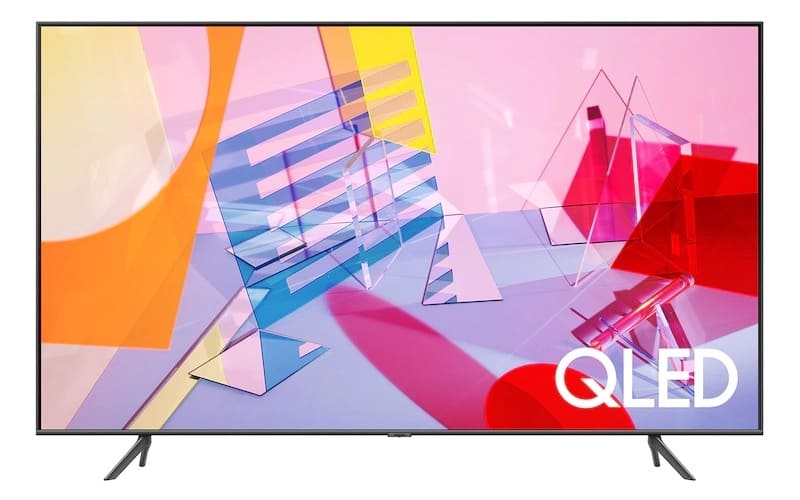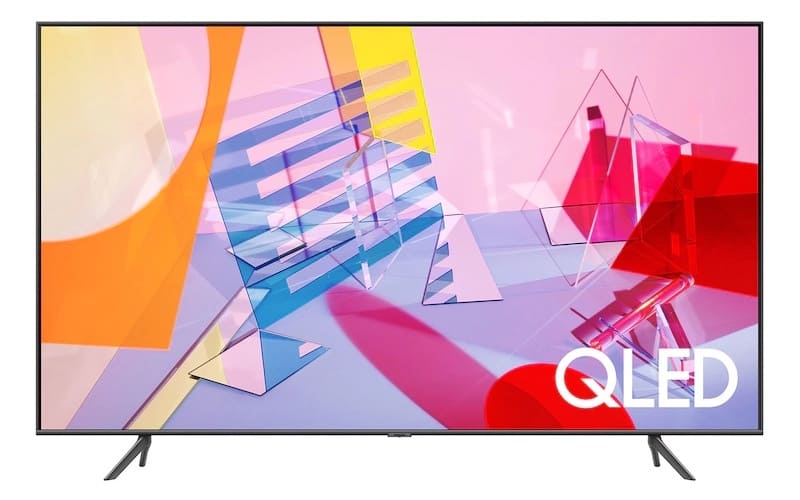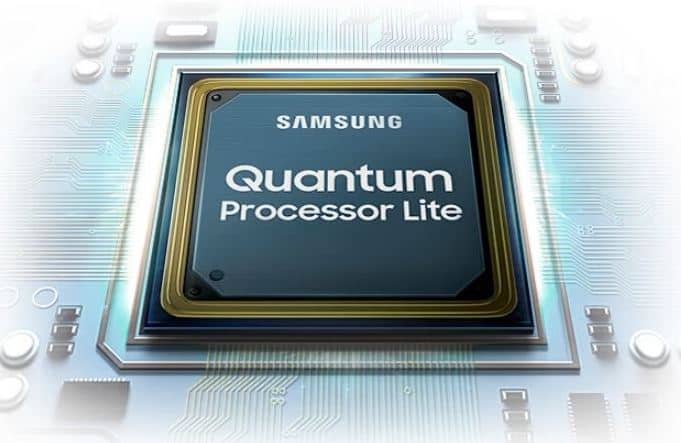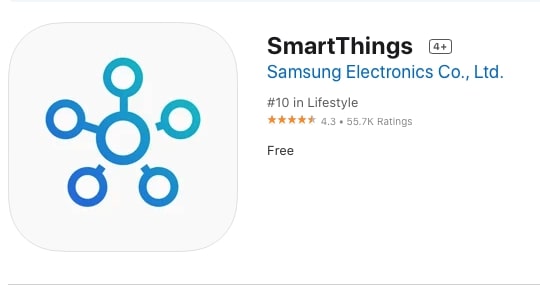The Q6DT and the Q60T are two basic models from Samsung’s 4K QLED TV lineup. But, just how similar are these two TVs, and which one is more suitable for your needs and preferences? Read this detailed Samsung Q6DT vs Q60T comparison page and learn everything you need to know about these two models.
Samsung Q6DT vs Q60T – Quick Comparison
Samsung Q6DT

The Q6DT is undoubtedly one of the most beautiful 4K TVs in its price range, a sleek TV with a minimalistic aesthetic and a frameless look. Still, it boasts a very sturdy construction with a strong metal chassis. Here are the Q6DT’s most significant pros and cons:
Pros:
- Great price for a TV with its features
- HDR10+ and HLG
- Great voice assistant
- Impressive contrast ratio
Cons:
- 60 Hz panel
- Edge-lit screen
Samsung Q60T

The Q60T is the cheapest 4K QLED TV in Samsung’s lineup and offers good all-around features that make it a prime choice for budget buyers. Let’s take a closer look at the biggest advantages and disadvantages of the Q60T:
Pros:
- Great price for a TV with its features
- HDR10+ and HLG
- Capable Smart TV platform
- Impressive contrast ratio
Cons:
- No gaming features
- No local dimming
Features Face to Face
Panel Technology
The Q6DT and the Q60T have the same Samsung QLED panel technology. QLED stands for quantum dot light-emitting diode, a panel technology with different performance properties than traditional LED panels. Samsung’s QLED panels can get significantly brighter than regular LED panels and offer great native contrast ratio numbers.
According to the information listed on the official Samsung website, the Q6DT comes in six screen sizes. On the other hand, the Q60T comes in eight screen sizes ranging from 43’’ to 85’’, meaning that this TV provides you with more options if you have a specific screen size in mind for your room.
Image Processor
Both TVs use the Quantum processor Lite, so they have identical image processing capabilities. This processor is the more streamlined and less powerful version of the 4K Quantum Processor in high-end Samsung TVs.

The Quantum Processor Lite is a four-core 1.5GHz processor that supports a 60 Hz refresh rate but unfortunately doesn’t offer 120 Hz refresh rate compatibility. Still, it’s very adept in mastering HDR content and optimizing color traits, so it’s still a solid processor for a 4K TV like the Q6DT and the Q60T.
Motion Technology
The Q6DT and the Q60T deliver average response times and mediocre motion technology overall. Going into specific numbers, they can fully transition between scenes in about 18 milliseconds, which is a bit more than the desired 14 milliseconds or better benchmark. Accordingly, there is some blur and overshoot in fast-moving scenes.
The two TVs use the 120 Refresh Rate Technology. That said, this name shouldn’t fool you. It actually refers to a 60 Hz refresh rate native to these two models because the motion rate value is calculated as twice the native refresh rate.
Picture Quality
The Q6DT and the Q60T deliver good picture quality for TV models in their price range. That said, when comparing their supported resolutions, it’s impossible to differentiate between the Q6DT and the Q60T. To see for yourself what we mean by this, check out the comparison table below:
| Resolution | Q6DT | Q60T |
|---|---|---|
| 4K/120Hz | No | No |
| 4K/60Hz/4:4:4 | Yes | Yes |
| 4K/60Hz | Yes | Yes |
| 1440p/120Hz | No | No |
| 1440p/60Hz | Yes (Native Support) | Yes (Native Support) |
| 1080p/120Hz | No | No |
| 1080p/60Hz/4:4:4 | Yes | Yes |
Contrast Ratio / Black Level
The Q6DT and the Q60T both offer an exceptional native contrast ratio. Although the exact contrast may vary slightly from set to set, you can expect a contrast ratio of around 7000:1, which is well above the 3000:1 standard. This means that the Q6DT and the Q60T can display deep blacks and deliver top-quality dark scenes when watching content in a dark room.
Local Dimming
Neither the Q6DT nor the Q60T has a local dimming feature. Instead, both models come with the so-called Supreme UHD Dimming setting, a software that automatically adjusts the image contrast over targeted screen zones. Additionally, these two models are edge-lit. This is the less favorable option, as full-array TVs are the preferred choice in this category because they deliver better screen uniformity.
Peak Brightness
The Q6DT and the Q60T have excellent SDR brightness and average HDR brightness. Speaking of the latter, they can’t get as bright in HDR as they can in SDR. More specifically, they can’t make small highlights as bright as they should, so they sometimes fail to reproduce vivid colors in their original appearance.
In the context of SDR brightness, the Q6DT and the Q60T can get bright enough to combat glare in most environments. Equally as important, they can remain consistently bright for the most part.
Color
The Q6DT and the Q60T have an equally good color gamut. It’s wide enough to provide solid DCI P3 color space coverage and deliver excellent HDR content quality. The Rec. 2020 coverage is okay on both models.
Like most Samsung models, the Q6DT and the Q60T have a color volume that’s slightly worse than their color gamut. In other words, both TVs can produce dark and saturated colors, but their high contrast ratio makes it challenging for them to display brighter colors, especially brighter blues.
Viewing Angle
Although the Q6DT and the Q60T offer pretty good performance in the most crucial performance categories, they noticeably underperform as far as their viewing angles go. This is not a notch against these two models in particular, as most VA panel TVs struggle to deliver wider viewing angles.
They start showing brightness loss at around thirty degrees and display gamma shifts and black shades at around fifteen degrees. This results in accuracy loss and washed-out images as soon as you move slightly off-center. Consequently, neither TV is suitable for a wider seating arrangement.
Reflections / Anti-glare
When it comes to their reflection handling properties, the Q6DT and the Q60T are nothing more than mediocre. They have a semi-gloss screen finish that doesn’t handle ambient light as efficiently as glossy screen finishes.
Both TVs reflect about five percent of the total light that hits their screen surface and less than one percent of all indirect reflections. All of this means that they offer respectable performance in moderately-lit or well-lit rooms but struggle in bright environments or when placed directly across a window.
Sound Quality
The speaker quality in the Q6DT and the Q60T is mediocre. Both TVs have a basic speaker system that can deliver reasonably loud audio but can’t produce a strong bass. The sound settings are somewhat barebone, so you shouldn’t expect any advanced features like room correction.
Smart TV Platform (Operating System)
The two TVs use the same 2020 OS version of Samsung’s Tizen Smart TV platform, so they have the same Smart TV properties. It’s important to mention that these two models use the reduced 2020 Tizen version, which is more capable than the 2019 version but not as complete as the 2020 version. It’s relatively easy to use even if you’re a beginner and an excellent platform for more experienced Smart TV users, as it has many advanced features.
This Tizen OS version loads up most apps within a couple of seconds and does include ads on the home page and app store, which you can’t disable. Looking at the app selection, you can take full advantage of Samsung’s massive app store. Lastly, this Smart TV platform supports HDR content on both Netflix and Youtube.
Connectivity
As the Q6DT and the Q60T have identical connectivity characteristics, we’ll primarily focus on what they include. From this perspective, we’ll look at their input specifications, voice assistant properties, and supported wireless technologies.
Inputs
If the categories we’ve discussed above haven’t convinced you just how similar these two TVs are, looking at their input properties surely will. To see just how closely the two TVs resemble each other in terms of overall port availability, here’s a table comparison of the key input connectivity features:
| Input Ports | Q6DT | Q60T |
|---|---|---|
| HDMI Ports | 3 HDMI 2.0 Ports | 3 HDMI 2.0 Ports |
| USB Ports | 2 USB 2.0 Ports | 2 USB 2.0 Ports |
| Digital Optical Audio Out | 1 Port | 1 Port |
| Ethernet Port | Yes | Yes |
Voice Assistants
For two entry-level 4K TVs, the Q6DT and the Q60T offer impressive voice assistant properties. This is because both TVs come with the SamsungSmartThings app that all Samsung TVs share.

The trademark recognizable and simplistic Samsung small remote remains unchanged from previous variations, like the Q60R. There’s a built-in microphone that enables you to interact with Samsung’s Bixby voice assistant. Following your voice commands, Bixby can change inputs, adjust specific settings, and launch apps.
Wireless Technologies
Similar to the previous two categories, there’s no visible difference in supported wireless technologies. The two TVs support the standard wireless technology (2.4GHz and 5GHz). Furthermore, both the Q6DT and the Q60T offer Bluetooth connectivity features. This enables you to connect a Bluetooth speaker or headphones if you find their sound properties insufficient.
Standout Features
The Q6DT and the Q60T both deliver well-rounded features, so neither model has any standout characteristics over the other one in this Q6DT vs Q60T comparison. That said, the two TVs share some features that help them stand out from other entry-level 4K TVs. They both support HDR10, HDR10+, and HLG.
When it comes to negative aspects that stand out in these two TV sets, there’s an apparent lack of advanced gaming features. Neither the Q6DT nor the Q60T offer VRR compatibility nor features like FreeSync and G-SYNC support.
Conclusion
As you’ve noticed through many different categories of this Samsung Q6DT vs Q60T comparison page, these two TVs are basically identical in many vital determinants. They feature the same panel technology, have several indistinguishable picture quality properties, and are both affordable.
The critical difference between the two models is that the Q6DT is an exclusive model you can only find in warehouse clubs like Sam’s Club and Costco. In contrast, the Q60T is a non-exclusive offered by common retailers.
With this in mind, the best way to decide between these two TVs is by price. If you find one model at a lower price than the other one, you should pick the lower-priced set, as you’re getting the same features either way you choose.
RELATED: See our Q60T vs Q70T Comparison